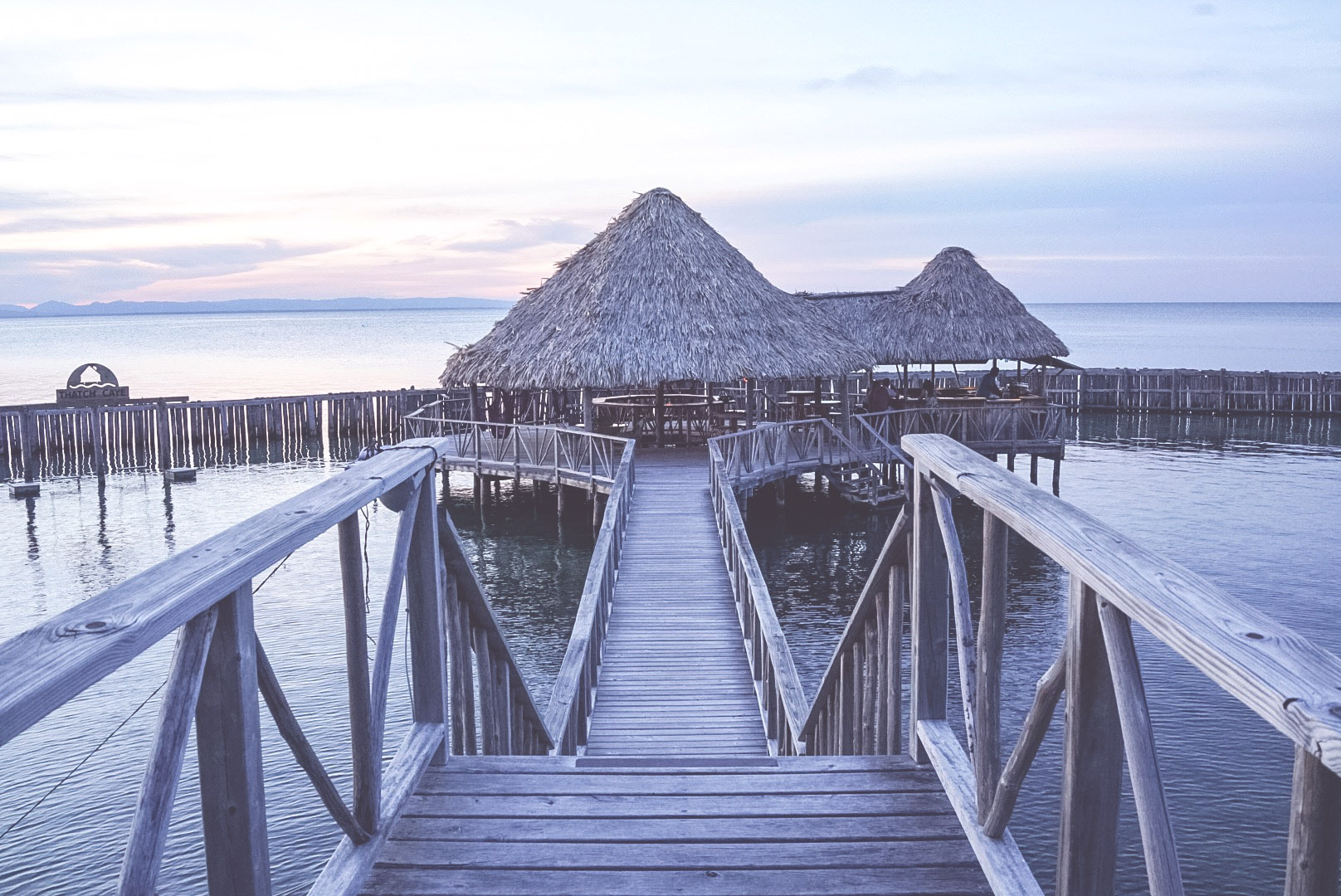Is September and October Really Belize’s “Worst Time to Visit”?
Belize in October
A cheap flight to Belize in September or October may seem like a great deal at first. That is, until you Google "October in Belize" and see the warnings about rain, hurricanes, and claims of it being a terrible time to visit.
At least that was my experience when I snagged a $266 roundtrip flight on Going (formerly Scott’s Cheap Flights) from San Francisco to Belize. Despite the warnings, my friend and I went anyway. I thought, “How bad could this be?”
Turns out, not that bad. Even though we were a bit nervous about traveling during what’s supposedly one of the worst months to visit Belize, we quickly discovered "worst time in Belize" doesn't equal "terrible trip". In fact, there were some hidden perks to traveling in a season most would rather avoid. If you're thinking of going to Belize in the fall, here’s what to expect and tips for traveling to Belize in September and October.
October weather in Belize is rainy but not all the time
Hopkins, Belize in October
October is Belize’s rainy season, but that doesn’t mean it’s raining 100% of the time. Like many tropical regions, the mornings tended to be dry while the afternoons saw a likelier chance of rain.
So even if it rains throughout the night, you might still wake up to no rain and an overcast sky—which isn’t such a bad thing in 90-degree weather. Also, if it looks like it’s about to start pouring, just find a place to hang out for the next hour and wait it out. Throughout our stay, we actually didn't get rained on all that much.
What about risk of hurricanes?
That said, the highest risk for hurricanes and tropical storms in Belize is in September and October—though, thanks to Belize’s geographic position it tends to be hit less frequently and less harshly than many neighboring Caribbean islands, Florida, and Honduras. In fact, it’s one of the better places in the Caribbean to visit during the region’s hurricane season, which typically peaks around August and September.
That said, it’s always a possibility, so it’s best to be prepared and invest in travel insurance before you go. WorldNomads, VisitorsCoverage, and Allianz are my top three recommendations for travel insurance. Although I have never had to use travel insurance while on the road, I have bought insurance from each of these companies in the past. Though their coverage plans may differ in little ways (always read the fine print and compare), all three are generally pretty affordable and have easy to sign-up for insurance options, including coverage plans that will reimburse you for your expenses or help you get home in the case of a natural disaster. For this trip, double check that your insurance will cover you against natural disasters before you purchase—not all plans do.
Know what to pack for rainy travel
Tikal, Guatemala: a quick 1.5 hour drive from San Ignacio, Belize
I once had a friend who said "there's no such thing as bad weather, just bad clothing." While I would disagree that there’s no such thing as bad weather, it’s true that it sucks less if you’re prepared and have the right gear. If you're heading to Belize—or any country— in rainy season, you’ll want to make sure you pack:
A rain cover for your backpack or waterproof backpack: If you travel with a backpack as your main luggage, get a rain cover to keep your stuff dry. Sea to Summit is my go-to brand for all things waterproof, and I love their durable and effective (though a tad pricey) rain cover ($30). However, I recently switched to the Charlie backpack by Remote Equipment ($270) that is 100% waterproof (which I have tested and confirmed in a torrential downpour) and no longer travel with a rain cover, since it’s redundant.
Waterproof daybag: I’ve also tested Matador’s packable daybag ($80), which is another good option for a waterproof backpack that you want to bring with you but not necessarily use as your main luggage, since it packs down super small.
Waterproof or quick-drying shoes: Skip the flip-flops (which can splash mud on your calves) and opt for a waterproof or quick-drying sandal with ankle straps, such as the Crocs LiteRide Sandal ($37) or the tried-and-true Teva Classic sandal ($30-40), which are always ready for adventure.
Dry-sacs for your electronics. I always keep my camera, notebook, and passport in a waterproof dry sack by Sea to Summit ($9 - 25). However, while in Belize, my travel partner, Nadia, introduced me to Earth Pack ($32), a dry bag with a strap that can double as a day bag.
Rain jacket or poncho. A rain jacket, such as Columbia’s lightweight rain shells ($40) is an essential for rainy climates. However, a poncho, such as those by Frogg Tog ($12) is often a better option in hot weather since they’re more breathable.
Travel umbrella. Pick something lightweight and compact, like the Repel Easy Touch Umbrella ($22).
Bug spray. Rain = mosquitoes, since they breed in pockets of still water. I used to travel with Ben’s 30% deet bug spray, which is super effective and comes in a carry-on friendly 3.4 oz bottle. But after it leaked in a toiletry bag and melted (yes melted) some plastic items, I switched to a natural bug spray by Kinfield ($24), which is the first non-deet bug spray I’ve ever used that’s actually been effective.
Some (but not all) attractions may be closed due to weather
Cahal Pech Ruins in San Ignacio
We spent our first few days in the small, western town of San Ignacio near the Guatemalan boarder. This town is typically a great jumping off point for exploring nearby Mayan Ruins or the Actun Tunichil Muknal (aka ATM) cave. Unfortunately, heavy rains meant we couldn’t reach either (even though others had been there just days before).
Still, many of the bigger attractions were still easily accessible–like Cockscomb Jaguar Sanctuary and the Blue Hole. We ended up taking a day trip over the border to see Guatemala’s famed Tikal ruins instead (it's actually easier to get to Tikal from San Ignacio, Belize than it is from Antigua or Guatemala City, Guatemala), and we were not disappointed. Our only regret? Not making it an overnight excursion, so we could spend more time exploring the nearby town of Flores, Guatemala.
While you’ll find plenty to do regardless of the weather, it can affect access to some of Belize’s attractions. Be prepared to be flexible.
Off season means cheaper prices and fewer tourists
Ka'ana Resort in San Ignacio
There is an upside to traveling to Belize in September or October: fewer tourists and cheaper prices. Since it’s low season, tour groups may be smaller, restaurants not as crowded, and hotels will have plenty of availability. Hotels and tour groups will also run discounts or be willing to negotiate. Both of these factors make it easy to travel affordably and without much of a plan — if that’s your style.
For example, on the first leg of our trip, we stayed at Ka’ana Resort & Spa and absolutely loved it. Each of the rooms are super private and really feel like you’re immersed in the jungle. There’s also a heated pool, spa, and restaurant with bar on-site. But the best part was that we were able to pay about $100 less per night during the low season than we would have during peak travel season—and we even booked fairly last minute (only a few weeks out).
October is the beginning of conch season
Conch Ceviche
Second upside: October is the start of conch season. Conch, similar to calamari in texture and flavor, is a popular food not just in Belize but throughout the Caribbean. While you’re there, keep an eye out for fresh conch dishes, such as a refreshing conch ceviche, crispy conch fritters, or savory conch soup.
FYI: Belize also celebrates Columbus Day
We planned our trip over the Columbus Day weekend to take advantage of the extra time off work. However, it wasn’t until we arrived in Belize we realized that it’s a bank holiday there as well. A few businesses (including banks and some restaurants) closed and busses ran less frequently, but otherwise it wasn’t an issue — much like in the U.S.
Should you travel to Belize in September or October?
Yes! It may be rainy in Belize in September and October, but there’s also lots of availability in hotels, fewer tourists, cheaper prices, and (oh yeah) fresh conch. Just be sure to pack right and get travel insurance if you’re worried about any weather related travel disruptions. Now, get out there and climb a Mayan ruin.
ENJOY THIS POST? SUPPORT MY WORK 😊
As an independent creator, a small thanks goes a long way!
This post was originally published in 2019. It is regularly updated to include current information and up-to-date product recommendations, and was most recently updated on September 15, 2023.






